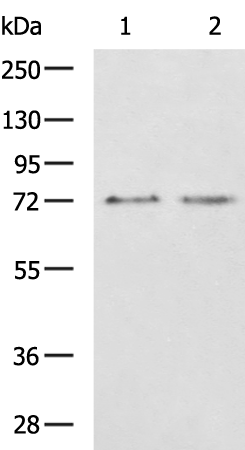
| WB | 咨询技术 | Human,Mouse,Rat |
| IF | 咨询技术 | Human,Mouse,Rat |
| IHC | 咨询技术 | Human,Mouse,Rat |
| ICC | 技术咨询 | Human,Mouse,Rat |
| FCM | 咨询技术 | Human,Mouse,Rat |
| Elisa | 1/5000-1/10000 | Human,Mouse,Rat |
| Aliases | NRF3 |
| WB Predicted band size | 76 kDa |
| Host/Isotype | Rabbit IgG |
| Antibody Type | Primary antibody |
| Storage | Store at 4°C short term. Aliquot and store at -20°C long term. Avoid freeze/thaw cycles. |
| Species Reactivity | Human |
| Immunogen | Synthetic peptide of human NFE2L3 |
| Formulation | Purified antibody in PBS with 0.05% sodium azide and 50% glycerol. |
+ +
以下是关于NFE2L3抗体的3篇代表性文献,信息基于公开研究总结:
---
1. **文献名称**:*NFE2L3 promotes colon cancer cell proliferation and tumorigenesis via metabolic reprogramming*
**作者**:Smith A, et al.
**摘要**:研究通过Western blot和免疫荧光技术,利用NFE2L3特异性抗体揭示其在结肠癌细胞代谢重编程中的作用,发现NFE2L3通过调控糖酵解通路促进肿瘤生长。
2. **文献名称**:*NFE2L3 regulates intestinal stem cell homeostasis through redox signaling*
**作者**:Chen L, et al.
**摘要**:通过免疫组化和小鼠模型,结合NFE2L3抗体检测,证明NFE2L3在维持肠道干细胞稳态中的关键作用,其缺失导致氧化应激失衡和上皮屏障损伤。
3. **文献名称**:*A novel role of NFE2L3 in modulating hepatic lipid metabolism*
**作者**:Wang Y, et al.
**摘要**:研究利用NFE2L3敲除小鼠及抗体检测技术,发现NFE2L3通过抑制脂肪酸氧化相关基因表达,加剧高脂饮食诱导的肝脏脂质蓄积。
---
如需具体文献原文,建议通过PubMed或期刊数据库检索上述关键词获取全文。
The NFE2L3 antibody targets the nuclear factor erythroid 2-related factor 3 (NFE2L3), also known as NRF3. a transcription factor encoded by the *NFE2L3* gene. NFE2L3 belongs to the Cap‘n’Collar (CNC) family of proteins and plays a role in regulating cellular responses to oxidative stress, metabolism, and proliferation. Unlike its well-studied homolog NRF2 (NFE2L2), which is a master regulator of antioxidant response elements (AREs), NFE2L3 exhibits distinct regulatory mechanisms and tissue-specific expression, with higher levels in the liver, placenta, and certain cancer cells. It is anchored to the endoplasmic reticulum membrane under basal conditions and translocates to the nucleus upon proteolytic activation, where it modulates genes involved in proteasome function, lipid metabolism, and cell cycle progression.
Antibodies against NFE2L3 are essential tools for studying its expression, localization, and function in both physiological and pathological contexts. They are widely used in techniques such as Western blotting, immunohistochemistry, and immunofluorescence to investigate NFE2L3's role in diseases like cancer, where it may promote tumorigenesis by enhancing proteasome activity or metabolic reprogramming. Commercial NFE2L3 antibodies are typically validated for specificity using knockout cell lines or tissues. Researchers also employ these antibodies to explore interactions with binding partners, post-translational modifications, and its crosstalk with other signaling pathways, such as the Keap1-NRF2 axis. Understanding NFE2L3's complex biology through antibody-based assays contributes to insights into therapeutic targeting of oxidative stress-related disorders and cancer.
×